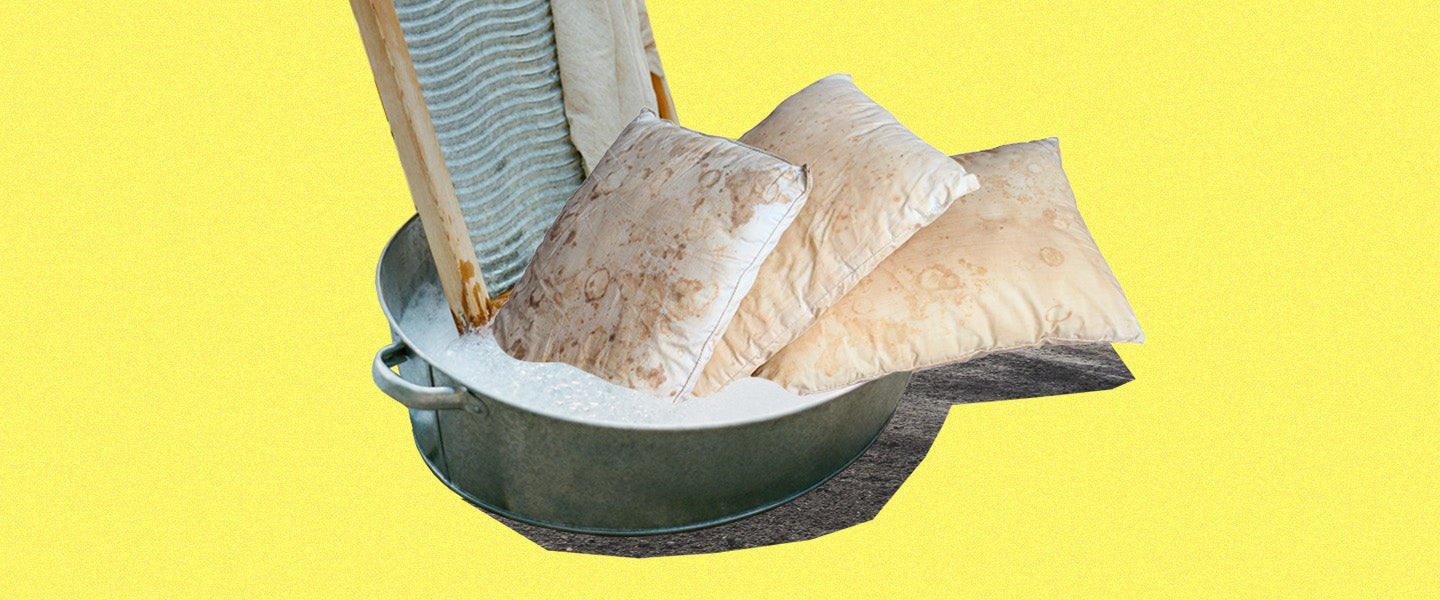A clean, freshly made bed is a glorious sight. “Sleep in me,” it says. “Crawl into me, forget all your worries and sleep the sleep of a champion. Dream the pleasant dreams of the stress-free, and awake refreshed and invigorated for a day of splendidness.” It’s like Pennywise inviting you into the drain, but all snuggly and warm and without the dismemberment and death.
Take the pillowcases off, though, and you’re met with a real shitshow. By the time you’ve had a pillow for a year or so, where once it was white, it’ll sport big, overlapping yellowed blotches, like a treasure map from a prop store. This is, for the most part, sweat, but it might also be joined by drool, grease, hair gel, makeup and, uh, any other substance that might find itself on one’s face, in one’s hair or generally flung about in a bedroom. Pillows are also full of dead skin cells and allergy-exacerbating dust mites: It’s grim. A Turin Shroud of filth. Your pillow can end up double its original weight due to all the hideousness it picks up, which is a goddamned disgusting thought.
At the risk of slightly exaggerating, placing a fresh pillowcase on an unwashed pillow is the bedding equivalent of sliding a new pair of clean white underpants onto a poop-covered ass. Most people sleep with two pillows — that’s two asses, covered in poop. Cohabiting? That’s a four-pooped-ass bed. Something must be done.
We should really all be washing our pillows more — every three to six months, according to experts. Nobody does this. A very informal, completely unscientific survey of 10 people (some of us don’t have many friends, okay?) asking whether they washed theirs resulted in eight nos, one “about annually” and one “about every two years.”
Why don’t we do it? Sheer idleness? Fear of ruining them? Fear of ruining our washing machines? Whatever it is, they’re all things we can, and should, get beyond. We stink. We all stink.
First, some types of pillow will get destroyed by a regular washing machine. If you have feather pillows, take them to a dry cleaner rather than completely screwing them up and filling your washing machine with feathers. Memory foam is best vacuumed and spot-treated or, if you must, handwashed — submerge it in a bucket of water with detergent, swoosh it around a bit, rinse it a bunch and lay it to dry somewhere warm.
But anything else — cotton, synthetic down and so on — should be fine. Check the label if it hasn’t been rendered unreadable by the decade of grotesque, brown sweat seeping out of your vile, snoring mug. If going for it in your washing machine, wash a few pillows at once on a slow, gentle cycle. As well as detergent, use bleach and, if you’re the sort of person that has borax in your house (i.e., if you’re a slime-based YouTuber), borax. Set your machine to do an extra rinse cycle.
Dry your pillows on a low heat. If you want the kind of fluffy-ass pillow you can really lose yourself in, get a pair of white socks and a pair of tennis balls. Thumb a ball into each sock, tie a knot in them and throw them into the dryer with the pillows. They’ll literally kick your pillow into ultimate floofiness.
Whatever your pillow is made of, putting it back on your bed before it’s properly dry is a terrible idea. You’ll end up with mold and mildew, a real step up in the grossness stakes from the sweat and drool that began this whole thing. It’s also important to know when a pillow has had it — most will only last a few years. If you fold a (non-feather) pillow in half and it doesn’t spring back, it’s done for.
Look, you’re not going to die from Stinky Pillow Disease. But you could do a lot worse than, twice a year — say, when daylight savings starts and ends — giving your pillows a spin. You wouldn’t want to rest your head on an unwiped butthole, after all. A biannually-wiped one, though? Terrific!

